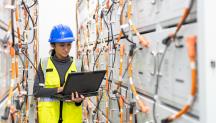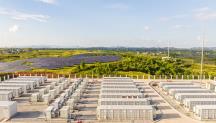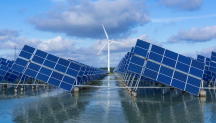

Renewable Energy is Enabling a World of Cheap, Abundant Electricity
Newsletter
When it comes to decarbonizing the end-use sectors, the stakes are high. Transport, buildings and industry account for 63% of current CO2 emissions and air pollution from these sources claims millions of lives every year. But according to IRENA research, to limit climate change and achieve sustainable growth the deployment of renewables must increase six-fold compared to the status quo. This includes a doubling of electricity in the total energy mix, most significantly in transport and heating and cooling.
Using current ways to manage and operate electricity systems, this would be challenging. Fortunately, disruptive technologies, markets and business practices are already emerging – from heat pumps, electric vehicles and electricity storage to virtual power plants and demand response – and being applied by pioneering governments, companies and organisations. These developments provided a rich basis for delegates from nearly seventy countries to discuss, dissect and debate key innovations fostering in electrification at IRENA Innovation Week 2018.
One area of focus was the building sector – especially heating and cooling. Participants noted that there has been significant progress in the past few years in the uptake of heat pumps. The market for heating systems in Europe is growing, with France at around 25% of the total market share, and Germany and the Netherlands both around 12%. Heating markets in Scandinavian countries are already dominated by heat pumps, but in many markets around the world new sales of heating equipment are still dominated by fossil fuel systems.
Electric heat pumps in combination with storage solutions, either electric or thermal, can provide low-cost flexibility for the operation of the electricity system, but work is still needed to adapt the current infrastructure. As Thomas Nowak, Secretary-General of the European Heat Pump Association noted, “The heat pump industry is not on the radar of people compared to electric vehicle charging, but it is no less important. Cities must consider the electricity needs and infrastructure needed to scale-up the electrification of domestic heating.” This, combined with measures to bring markets to scale have the potential to rapidly expand renewable-powered electric heating and cooling of homes and industry.
The electrification of transport was also discussed, in light of the staggering growth of electric vehicles worldwide in the past few years. While it still represents a small proportion of the overall market, e-mobility is a sector beyond the tipping point, with economics set to drive mass adoption. To ensure that this goes hand-in-hand with the decarbonisation of power systems, a massive scale-up is needed in smart charging infrastructure and advances in grid load management and capacity. Achieving this could see over one billion electric vehicles on the road by 2050.
The synergies between electrification of end-use sectors and accelerated renewables deployment are very strong. But during the conference it was stressed that smart approaches to electrification are crucial to harness the synergies. For example, different demands are placed on the grid when large numbers of electric vehicles are charged at the same time during periods of low wind or solar energy availability compared to when abundant wind and solar radiation is available. Technology innovation has to be accompanied by innovative business models and market regulations to ensure that electrification becomes a driver and not a constraint of the global energy transformation.
As Dolf Gielen, Director of the IRENA Innovation and Technology Center pointed out, this calls on local, regional and national governments to start asking themselves new questions: "Does every parking spot in a city need a smart charging point? Do we have rights to put charging points in houses? If we do, who owns those charging points and who is responsible for maintaining them?"
Other issues discussed include power transmission over long distances, and the challenges associated with managing energy systems with thousands of points of entry. Innovations in ultra-high voltage grids coming out of China and artificial intelligence are two of the most exciting areas in this respect, and though further progress is needed to create the autonomous energy systems of the future, as NREL’s Martin Keller put it, “the potential is boundless.”
Finally, battery storage is one of the most critical, and one of the most exciting, areas where innovations are expanding the horizons of what is possible with regards to the electrification of end-use sectors. Battery electric storage systems are facilitating an increasing share of renewable energy, and supporting grid management and operation. As IRENA’s Electricity storage and renewables: Costs and markets to 2030 report found, battery storage in stationary applications could grow 18 to 42-fold by 2030 from 10 gigawatt-hours (GWh) in 2017 to 181-421 GWh in 2030. Innovations will drive costs lower, expand the lifetimes of batteries and improve their performance, and the economics of applications that will provide scale for industrialisation of manufacturing and allow battery storage to scale are now being tested.
Strategen’s Mark Higgins summed up the issue, “It’s not only costs that are driving the rapid growth of battery storage, but also the value. Our regulatory environment is designed for the 20th century and now it needs reform.” Innovations, therefore, must extend beyond the technological to encompass regulatory and institutional change, and market reform. Hydrogen could provide further scope for introducing flexibility for power systems, as well as for seasonal storage of electricity from variable renewable energy. In fact, as the report, IRENA Technology Outlook: Hydrogen from renewable power, which IRENA launched during Innovation Week, found, hydrogen could be the ‘missing link’ needed to transform the global energy system.
The electrification of the end-use sectors still has a long way to go, but as IRENA Innovation Week demonstrated, there are no shortage of ideas, nor is there a lack of people who are motivated to put those ideas into practice. As IRENA Director-General Adnan Z. Amin put it: “We are moving to a world where there is going to be cheap, abundant electricity. The challenge is to discover the innovations that will make this most useful in our society.”




